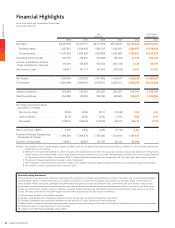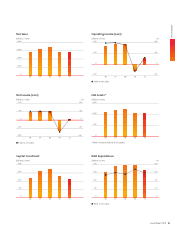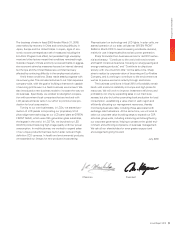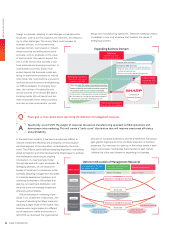Sharp 2010 Annual Report Download - page 11
Download and view the complete annual report
Please find page 11 of the 2010 Sharp annual report below. You can navigate through the pages in the report by either clicking on the pages listed below, or by using the keyword search tool below to find specific information within the annual report.
Large-size LCDs/LCD TVs
With demand in emerging countries growing faster than expected,
supplies of LCD panels for TVs are projected to remain tight until
fiscal 2011. The increasing popularity of LED TVs and 3D TVs is
another key dynamic in this market. Only a few manufacturers in
the world can supply panels with high definition and brightness
required by these new technologies.
In order to meet the strong demand for high-performance panels,
we increased input capacity at the LCD panel plant in GREEN FRONT
SAKAI to 72,000 glass substrates per month. This plant produces
highly competitive LCD panels that feature Sharp’s proprietary tech-
nologies like UV2A technology and four-primary-color technology.
In the LCD TV business, we plan to increase sales by focusing
on our AQUOS Quattron models, which combine our UV2A tech-
nology and four-primary-color technology, and launching an
AQUOS Quattron 3D TV. We plan to have AQUOS Quattron TVs in
stores worldwide by the end of fiscal 2010. I am confident this will
add impetus to our brand restructuring. Concurrently, we will
convert all of our TVs to LED-backlit models. However, the supply
of LED chips is limited. As eliminating procurement risk is a key
factor in our business expansion, we have established cross-
licensing agreements with major LED manufacturers and started
making these chips ourselves. This will give us a well-balanced
framework for procuring LED chips. We started making blue LED
chips early in 2010 at our Mihara Plant and will begin mass pro-
duction at the Fukuyama Plant by the end of fiscal 2010. I am
confident that these initiatives will allow us to keep up with rapid
growth in demand for LED TVs.
Please explain your views of market conditions for Sharp’s core businesses and your strategies for achieving growth.
LCD/LCD TV Business
In the large-size LCD and LCD TV category, we plan to rebuild the Sharp brand around our proprietary LCD technology. For
small- and medium-size LCDs, we plan to improve profitability by utilizing continuous grain silicon (CG-Silicon) technology.
Sharp’s Strategies for Growth
Small- and Medium-size LCDs
The market for small- and medium-size LCDs remained difficult in
fiscal 2009 and the oversupply of these panels is likely to con-
tinue. But there is good news, too. Display functionality and defini-
tion are expected to improve as new applications like
smartphones and e-books emerge. The 3D touch panel is a prime
example of this trend. As demand climbs, I expect to see a supply
shortage of high value-added LCDs.
Amid these trends, in April 2010, we unveiled a 3D touch-
screen LCD that incorporates an advanced version of our CG-Silicon
technology, which is a key strength of ours in the LCD field. We
want to improve profitability in our small- and medium-size LCD
business by increasing sales of high value-added displays, a market
sector where we are very competitive.
Q
A
Interview with the President
Annual Report 2010 09
























